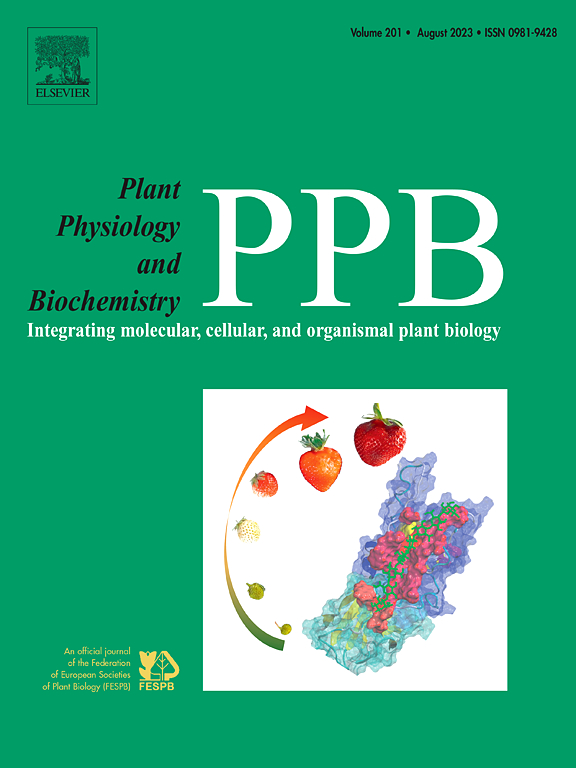白菜在形态、细胞和转录代谢水平上硫化氢防御黑腐病的研究
IF 5.7
2区 生物学
Q1 PLANT SCIENCES
引用次数: 0
摘要
油菜黄单胞菌引起的黑腐病。油菜锈病(Xcc)对十字花科作物造成了严重的经济损失。硫化氢(H2S)是一种重要的气体信号分子,参与介导植物对各种逆境的防御反应。因此,我们研究了外源H2S (1 mmol/L NaHS, H2S供体)对白菜抗氧化调控机制的影响,确定了硫化氢对黑腐病的有效防治。结果表明,Xcc抑制了白菜的抗氧化性能和次生代谢物的合成,导致细胞壁和细胞膜完整性的明显破坏,而H2S有效地减轻了这种抑制作用和损害程度。H2S处理可上调植物与病原体相互作用相关基因的表达水平,稳定渗透调控系统,提高抗氧化能力,促进GSH-ASA循环。此外,H2S显著保护细胞完整性,降低发病率,提高物质合成速度。结果表明,H2S在白菜黑腐病防治中具有很大的潜力。本文章由计算机程序翻译,如有差异,请以英文原文为准。
Insights into hydrogen sulfide defense against black rot of cabbage at morphological, cellular and transcriptional metabolic levels
Black rot caused by Xanthomonas campestris pv. campestris (Xcc) has led to severe economic losses in cruciferous crops. Hydrogen sulfide (H2S), an important gaseous signaling molecule, is involved in mediating plant defense responses to various adversities. Therefore, we investigated the mechanism of defense regulation against Xcc in cabbage using exogenous H2S (1 mmol/L NaHS, H2S donor) and determined that hydrogen sulfide was effective in controlling black rot. The results showed that Xcc inhibited the antioxidant properties and secondary metabolite synthesis of cabbage, leading to significant disruption of cell wall and cell membrane integrity, whereas the use of H2S effectively mitigated this inhibition and the extent of damage. H2S treatment up-regulated the expression levels of genes involved in plant-pathogen interactions, stabilized the osmoregulatory system, improved antioxidant capacity, and promoted the GSH-ASA cycle. Furthermore, H2S significantly protected cellular integrity, reduced morbidity, and increased the rate of substance synthesis. Our results suggest that H2S has great potential in controlling black rot of cabbage.
求助全文
通过发布文献求助,成功后即可免费获取论文全文。
去求助
来源期刊
CiteScore
11.10
自引率
3.10%
发文量
410
审稿时长
33 days
期刊介绍:
Plant Physiology and Biochemistry publishes original theoretical, experimental and technical contributions in the various fields of plant physiology (biochemistry, physiology, structure, genetics, plant-microbe interactions, etc.) at diverse levels of integration (molecular, subcellular, cellular, organ, whole plant, environmental). Opinions expressed in the journal are the sole responsibility of the authors and publication does not imply the editors'' agreement.
Manuscripts describing molecular-genetic and/or gene expression data that are not integrated with biochemical analysis and/or actual measurements of plant physiological processes are not suitable for PPB. Also "Omics" studies (transcriptomics, proteomics, metabolomics, etc.) reporting descriptive analysis without an element of functional validation assays, will not be considered. Similarly, applied agronomic or phytochemical studies that generate no new, fundamental insights in plant physiological and/or biochemical processes are not suitable for publication in PPB.
Plant Physiology and Biochemistry publishes several types of articles: Reviews, Papers and Short Papers. Articles for Reviews are either invited by the editor or proposed by the authors for the editor''s prior agreement. Reviews should not exceed 40 typewritten pages and Short Papers no more than approximately 8 typewritten pages. The fundamental character of Plant Physiology and Biochemistry remains that of a journal for original results.

 求助内容:
求助内容: 应助结果提醒方式:
应助结果提醒方式:


